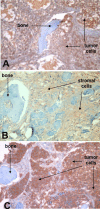Bone invading NSCLC cells produce IL-7: mice model and human histologic data
- PMID: 20067635
- PMCID: PMC2824709
- DOI: 10.1186/1471-2407-10-12
Bone invading NSCLC cells produce IL-7: mice model and human histologic data
Abstract
Background: Bone metastases are a common and dismal consequence of lung cancer that is a leading cause of death. The role of IL-7 in promoting bone metastases has been previously investigated in NSCLC, but many aspects remain to be disclosed. To further study IL-7 function in bone metastasis, we developed a human-in-mice model of bone aggression by NSCLC and analyzed human bone metastasis biopsies.
Methods: We used NOD/SCID mice implanted with human bone. After bone engraftment, two groups of mice were injected subcutaneously with A549, a human NSCLC cell line, either close or at the contralateral flank to the human bone implant, while a third control group did not receive cancer cells. Tumor and bone vitality and IL-7 expression were assessed in implanted bone, affected or not by A549. Serum IL-7 levels were evaluated by ELISA. IL-7 immunohistochemistry was performed on 10 human bone NSCLC metastasis biopsies for comparison.
Results: At 12 weeks after bone implant, we observed osteogenic activity and neovascularization, confirming bone vitality. Tumor aggressive cells implanted close to human bone invaded the bone tissue. The bone-aggressive cancer cells were positive for IL-7 staining both in the mice model and in human biopsies. Higher IL-7 serum levels were found in mice injected with A549 cells close to the bone implant compared to mice injected with A549 cells in the flank opposite to the bone implant.
Conclusions: We demonstrated that bone-invading cells express and produce IL-7, which is known to promote osteoclast activation and osteolytic lesions. Tumor-bone interaction increases IL-7 production, with an increase in IL-7 serum levels. The presented mice model of bone invasion by contiguous tumor is suitable to study bone-tumor cell interaction. IL-7 plays a role in the first steps of metastatic process.
Figures





Similar articles
-
Mixed metastatic lung cancer lesions in bone are inhibited by noggin overexpression and Rank:Fc administration.J Bone Miner Res. 2006 Oct;21(10):1571-80. doi: 10.1359/jbmr.060706. J Bone Miner Res. 2006. PMID: 16995812
-
Monocyte chemotactic protein 1 promotes lung cancer-induced bone resorptive lesions in vivo.Neoplasia. 2009 Mar;11(3):228-36. doi: 10.1593/neo.81282. Neoplasia. 2009. PMID: 19242604 Free PMC article.
-
Colony-stimulating factor 1 potentiates lung cancer bone metastasis.Lab Invest. 2014 Apr;94(4):371-81. doi: 10.1038/labinvest.2014.1. Epub 2014 Jan 27. Lab Invest. 2014. PMID: 24468794
-
[Multi-channel promotion of lung cancer progress by bone marrow derived mesenchymal stem cells in tumor microenvironment].Zhonghua Zhong Liu Za Zhi. 2018 Feb 23;40(2):85-91. doi: 10.3760/cma.j.issn.0253-3766.2018.02.002. Zhonghua Zhong Liu Za Zhi. 2018. PMID: 29502366 Chinese.
-
Bone metastasis model with multiorgan dissemination of human small-cell lung cancer (SBC-5) cells in natural killer cell-depleted SCID mice.Oncol Res. 2000;12(5):209-17. doi: 10.3727/096504001108747701. Oncol Res. 2000. PMID: 11417746
Cited by
-
Optimal timing for local ablative treatment of bone oligometastases in non-small cell lung cancer.J Bone Oncol. 2023 Aug 2;42:100496. doi: 10.1016/j.jbo.2023.100496. eCollection 2023 Oct. J Bone Oncol. 2023. PMID: 37589036 Free PMC article. Review.
-
Flip the coin: IL-7 and IL-7R in health and disease.Nat Immunol. 2019 Dec;20(12):1584-1593. doi: 10.1038/s41590-019-0479-x. Epub 2019 Nov 19. Nat Immunol. 2019. PMID: 31745336 Review.
-
Thymidylate synthase drives the phenotypes of epithelial-to-mesenchymal transition in non-small cell lung cancer.Br J Cancer. 2021 Jan;124(1):281-289. doi: 10.1038/s41416-020-01095-x. Epub 2020 Oct 7. Br J Cancer. 2021. PMID: 33024270 Free PMC article.
-
C-met inhibition blocks bone metastasis development induced by renal cancer stem cells.Oncotarget. 2016 Jul 19;7(29):45525-45537. doi: 10.18632/oncotarget.9997. Oncotarget. 2016. PMID: 27322553 Free PMC article.
-
An immune-related gene expression signature predicts brain metastasis in lung adenocarcinoma patients after surgery: gene expression profile and immunohistochemical analyses.Transl Lung Cancer Res. 2021 Feb;10(2):802-814. doi: 10.21037/tlcr-20-1056. Transl Lung Cancer Res. 2021. PMID: 33718023 Free PMC article.

